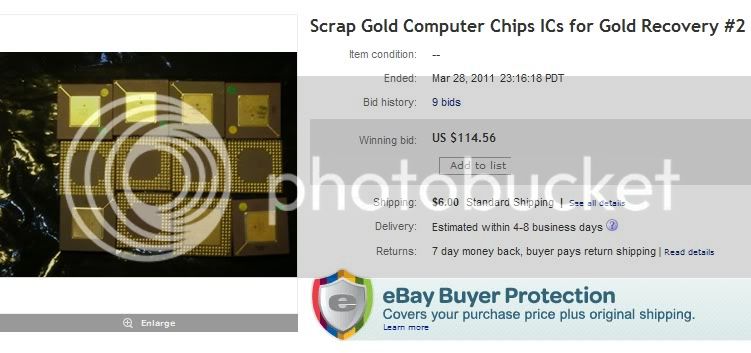What a find this forum is! Thank you for putting it together.
I am here because I have a renewed interest in refining and many of my Google searches for info pointed me to your forum.
It happened like this... I went to a local auction and bought a jewelry box lot because there was one thing inside I wanted. When I went through the box I e-bayed some of the items and set aside the marked items (1/20 GF). Then I started looking for an acid test kit to check out some of the other stuff and have started a bucket of unmarked stuff I think is gold filled and plated. To prevent gold fever, I will only buy box lots if they are very cheap ($5) or there is something I want inside.
So what to do with stuff I set aside? Refineries will take it and charge a refining and assay fee, so that is one way to go. But 15 or more years ago I did refining with nitric acid, so I knew I could separate the gold out. Can I do it safely and not endanger myself or my cats? Is it cost effective? I am in the process of answering these questions. This forum looks like the go to place.
So far I have learned that I don't need to spend money on fancy equipment like a furnace or a put together refining system. Posts here also confirm my observation that e-bay buyers are paying top dollar for marked GF scrap, so why waste time and money? And nitric acid is not the only method which is good because I don't remember it being so expensive. I remember having two rather large metal containers that we paid a deposit on, and swapped empties with full ones like propane tanks. Seems like it was 60 bucks for that container - had to be 3-5 gallons. But that was long ago.
So hello and thanks again for all the great posts to dig into.
Amber
I am here because I have a renewed interest in refining and many of my Google searches for info pointed me to your forum.
It happened like this... I went to a local auction and bought a jewelry box lot because there was one thing inside I wanted. When I went through the box I e-bayed some of the items and set aside the marked items (1/20 GF). Then I started looking for an acid test kit to check out some of the other stuff and have started a bucket of unmarked stuff I think is gold filled and plated. To prevent gold fever, I will only buy box lots if they are very cheap ($5) or there is something I want inside.
So what to do with stuff I set aside? Refineries will take it and charge a refining and assay fee, so that is one way to go. But 15 or more years ago I did refining with nitric acid, so I knew I could separate the gold out. Can I do it safely and not endanger myself or my cats? Is it cost effective? I am in the process of answering these questions. This forum looks like the go to place.
So far I have learned that I don't need to spend money on fancy equipment like a furnace or a put together refining system. Posts here also confirm my observation that e-bay buyers are paying top dollar for marked GF scrap, so why waste time and money? And nitric acid is not the only method which is good because I don't remember it being so expensive. I remember having two rather large metal containers that we paid a deposit on, and swapped empties with full ones like propane tanks. Seems like it was 60 bucks for that container - had to be 3-5 gallons. But that was long ago.
So hello and thanks again for all the great posts to dig into.
Amber











































































